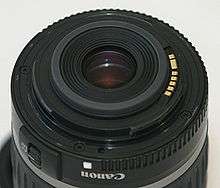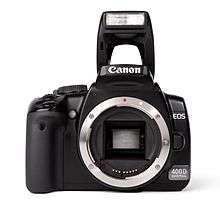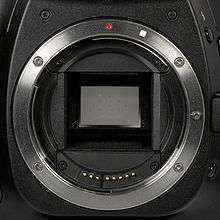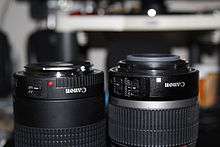Canon EF-S lens mount

The Canon EF-S lens mount is a derivative of the EF lens mount created for a subset of Canon digital single-lens reflex cameras with APS-C sized image sensors. It was released in 2003. Cameras with the EF-S mount are backward compatible with the EF lenses and, as such, have a flange focal distance of 44.0 mm. Such cameras, however, have more clearance, allowing lens elements to be closer to the sensor than in the EF mount. Only Canon cameras released after 2003 with APS-C sized sensors support the EF-S mount.
The "S" in EF-S comes from "Small image circle", meaning the lens is designed to provide a small (relative to a normal EF lens) image circle to match the sensor.[1] The smaller mirror used in APS-C cameras also allows optical elements to protrude further into the camera body, which enhances the possibilities for wide angle and very wide angle lenses, enabling them to be made smaller, lighter (containing less glass), faster (larger aperture) and less expensive.
Although not all Canon EF-S lenses use this short back focus, they cannot be mounted on DSLRs with sensors larger than APS-C. However, some lenses produced by third-party manufacturers may feature the standard EF mount if they do not require the shorter back focus but only have a small image circle. Such lenses will give noticeable vignetting if used on a 35mm film or full frame sensor cameras. To a lesser degree, vignetting also occurs with APS-H sensor sizes, such as several (now discontinued) cameras of the 1D series.
Compatibility
The cameras that can use the EF-S mount are:


By design, it is physically impossible to mount EF-S lenses on EF-only cameras. This is because the increased proximity of the lens to the sensor means that on full-frame sensor or 35mm film EF cameras the lens itself would obstruct the mirror's movement and cause damage to the lens and/or camera. While it is possible to modify the lens such that the physical obstruction is removed, allowing for mounting to EF mount cameras, the rear of the lens would still obstruct the mirror. An additional reason is that the lenses produce a smaller image circle of even illumination (circle of no vignetting). An EF-S lens alignment mark is indicated by a small white rectangle, whereas the EF employs a small red dot. The lens will insert into the body when the alignment marks on each are matched, and the lens can then be rotated and locked into the operating position. EF-S camera bodies have both EF-S and EF alignment marks, while EF bodies have only EF marks. Some have reported success attaching EF-S lenses to full-frame bodies with the use of an extension tube; however, this does not eliminate the vignetting problem, and also removes the lens's ability to achieve infinity focus.[2] Also, attachment of EF-S lenses on EF bodies can often be accomplished by removing the small plastic ring seen in the photo above. Although vignetting is still an issue, photos can be taken, and infinity focus achieved. This modification comes with caveats, one being that on some lenses, like the EF-S 10-22mm, at the 10mm setting, the element protrudes too far back toward EF mount camera bodies.
The 10D, D60, and earlier cameras share the EF-only mount with the full frame EOS camera bodies, and also with the APS-H size EOS camera bodies (1D series prior to the 1D X), despite having a smaller sensor and therefore a smaller mirror.
List of EF-S lenses
The EF-S lens mount is a relatively new offering from Canon, so the selection of available lenses is limited compared to the full EF range, but it is backward compatible with the EF mount, and can therefore still accept all EF lenses. The variety of EF-S prime lenses is very limited in comparison to EF-S zoom lenses. Only two in comparison to 9 zoom lenses. EF-S lenses are very popular due to their lower cost and prime lenses are more preferable by amateurs photographers. As of January 2016, no EF-S lens has been produced with the "L" designation or with Diffractive optics, and only two EF-S prime lenses have been produced.

| Focal length | Equivalent focal length (×1.6 crop factor) |
Minimum Aperture range | Mark | Introduced | Macro | USM | STM | IS | L-series | DO |
|---|---|---|---|---|---|---|---|---|---|---|
| 10–18mm | 16–28.8 mm | f/4.5–5.6 | 2014 | No | No | Yes | Yes | No | No | |
| 10–22mm | 16–35.2 mm | f/3.5–4.5 | 2004 | No | Yes | No | No | No | No | |
| 15–85mm | 24–136 mm | f/3.5–5.6 | 2009 | No | Yes | No | Yes | No | No | |
| 17–55mm | 27.2–88 mm | f/2.8 | 2006 | No | Yes | No | Yes | No | No | |
| 17–85mm | 27.2–136 mm | f/4–5.6 | 2004 | No | Yes | No | Yes | No | No | |
| 18–55mm | 28.8–88 mm | f/3.5–5.6 | I | 2003 | No | No | No | No | No | No |
| I (Jpn.) | 2003 | No | Yes | No | No | No | No | |||
| II | 2005 | No | No | No | No | No | No | |||
| II (Jpn.) | 2005 | No | Yes | No | No | No | No | |||
| III | 2011 | No | No | No | No | No | No | |||
| IS | 2007 | No | No | No | Yes | No | No | |||
| IS II | 2011 | No | No | No | Yes | No | No | |||
| IS STM | 2013 | No | No | Yes | Yes | No | No | |||
| 18–135mm | 28.8–216 mm | f/3.5–5.6 | IS | 2009 | No | No | No | Yes | No | No |
| IS STM | 2012 | No | No | Yes | Yes | No | No | |||
| IS USM | 2016 | No | Yes | No | Yes | No | No | |||
| 18–200mm | 28.8–320 mm | f/3.5–5.6 | 2008 | No | No | No | Yes | No | No | |
| 55–250mm | 88–400 mm | f/4–5.6 | I | 2007 | No | No | No | Yes | No | No |
| II | 2011 | No | No | No | Yes | No | No | |||
| IS STM | 2013 | No | No | Yes | Yes | No | No | |||
| 24mm | 38.4 mm | f/2.8 | STM | 2014 | No | No | Yes | No | No | No |
| 60mm | 96 mm | f/2.8 | 2005 | Yes | Yes | No | No | No | No |
References
- ↑ "Technical Hall - Technical report 2004.1". Canon.com. Retrieved 2013-06-10.
- ↑ "Canon EF-S 17-55mm f/2.8 IS USM Lens Review". The-digital-picture.com. Retrieved 2013-06-10.
External links
- Canon Camera Museum
- EF Lens Lineup at Canon USA
- EF/EF-S lens chart
- EF-S lenses compatible with a 10D
